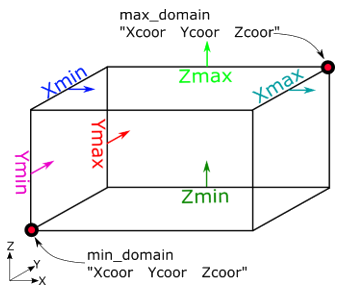Domain
In the domain section, the global definitions for the simulation are set, such as the number of dimensions and the numerical reference parameters.
Commands
domain
{
ndim 3
min_domain "0.0 0.0 0.0"
max_domain "1.0 3.0 0.0"
BC_min "OUTLET PERIODIC SIMPLEOUTLET"
BC_max "OUTLET PERIODIC SIMPLEOUTLET"
outlet_vel "0.05 0.0 0.0"
outlet_bodyforce_on true
ref_rho 1000.
ref_length 0.1
ref_vel 1.0
ref_curv 1.0
ref_visc 1.0
bodyforce "0. 0. 0."
t_damp_bodyforce_start 0.
t_damp_bodyforce_end 0.
bodyforcefile inputFileName.txt
inputfile initialparticlepositions.txt
inputfileReadMode AUTO
inputfile_factor 0.001
}- ndim
- The dimensionality of the problem
- min_domain
- Minimum bounds of the computational box (vector defining a point location)
- max_domain
- Maximum bounds of the computational box (vector defining a point location)
- BC_min (Domain parameters)
- Boundary condition at the minimum boundary
- BC_max (Domain parameters)
- Boundary condition at the maximum boundary

Figure 1. Sketch of the nanoFluidX Domain Boundaries.
Each of the six bounding planes is marked in a separate color, with the colored arrow showing the surface normal of the boundary. The direction of these surface normals in the sketch has no influence on the code execution, they are provided to help visualize the domain. The two red dots at the opposite corners of the domain are minimum and maximum extent of the domain.
- outlet_vel
- Specifies the velocity of the OUTLET boundary
- outlet_bodyforce_on
- If this flag is switched on, the outlet particles will experience the prescribed body force. This is useful in cases where the outlet plane is perpendicular to the body force (gravity) direction. In this case, the zero gradient velocity at the outlet no longer applies.
Reference values have been automated. They can be set manually, as is recommended. Depending on the case definition, the code will automatically pick up the reference values, provided that the max_dist command is defined in the motion definition.
For density, the lowest fluid density will be picked up as the reference. For length, the code will analyze the size of the domain in the direction of the body force applied and choose that length as the reference length. This means that if variable body force is being used, the reference length is specified manually.
For velocity, if there is defined motion in the configuration file, the code will automatically calculate maximal velocity of the motion, multiply it by a ref_vel_factor (the default value is 1.5) for conservative purposes, and set that value as the reference velocity. If there is no motion defined, or if the motion is rigid body or position file, the reference velocity must be defined manually. For reference curvature, the default curvature will be set as 1/(5*dx). In order to resolve droplets accurately, there needs to be a droplet radius of at least five particles.
- ref_rho
- Reference density
- ref_length
- Reference length: A typical length scale defining the relevant physics.
- ref_vel
- Reference velocity
- ref_curv
- Reference curvature (needed only if surften_model is set to ADAMI or SINGLE_PHASE).
- ref_visc
- Reference viscosity (needed only if viscTempCoupling is set to true).
- bodyforce
- Gravitational acceleration
- t_damp_bodyforce_start
- Before this time the body force is zero. Starting from this time, a
gravitational acceleration is added to the system. Note: Ramping up to the given value is defined with t_damp_bodyforce_start and t_damp_bodyforce_end commands.
- t_damp_bodyforce_end
- This time must not be smaller than t_damp_bodyforce_start. Within the time interval between t_damp_bodyforce_start and t_damp_bodyforce_end the gravitational acceleration is ramped up to reach the full body force at t_damp_bodyforce_end. At later times the full body force is applied.
- bodyforcefile
- Name of the file that contains the body force vector as a function of time, allowing simulations of sloshing tanks.
- inputfile
- This file is the geometry input file (textfile) and needs to be present in the folder where the simulation is launched together with the config-file.
- inputfile_factor
- This factor can be used to scale the input file content. Note: nanoFluidX uses SI-units. Therefore, this factor is useful if a model is created in SimLab in millimeter-units and needs to be converted to meters while reading in.
- inputfileReadMode
- Describes the data format that is to be read in.